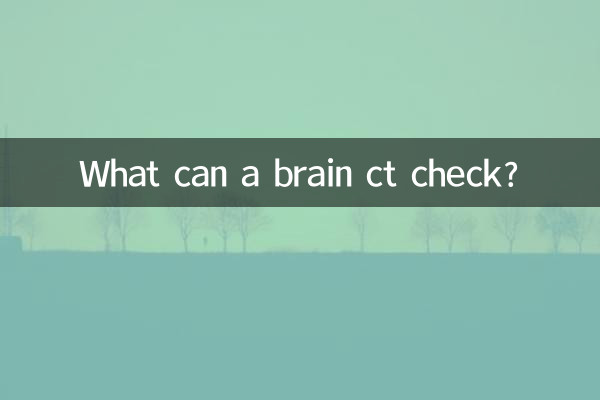What can a brain CT check?
Brain CT (computed tomography) is a commonly used medical imaging technology that can clearly display the internal structure of the brain and help doctors diagnose a variety of diseases. The following are the main examination contents and application scenarios of brain CT.
1. Basic functions of brain CT

Brain CT scans the head with X-rays to generate cross-sectional images, which can clearly display brain tissue, skull, blood vessels and other structures. The following are the main examination items of brain CT:
| Check items | Specific content |
|---|---|
| parenchymal brain lesions | Detect cerebral infarction, cerebral hemorrhage, brain tumor, brain atrophy, etc. |
| skull injury | Diagnose skull fractures, skull defects, etc. |
| cerebrovascular disease | Check for cerebral aneurysms, cerebral vascular malformations, cerebral thrombosis, etc. |
| intracranial infection | Diagnose encephalitis, brain abscess, etc. |
| hydrocephalus | Detect ventricular enlargement, cerebrospinal fluid circulation disorders, etc. |
2. Clinical application of brain CT
Brain CT is widely used in the following scenarios in clinical practice:
| Application scenarios | Specific use |
|---|---|
| emergency examination | Rapid diagnosis of emergencies such as cerebral hemorrhage and craniocerebral trauma |
| Preoperative evaluation | Provide accurate anatomical information for neurosurgery |
| Postoperative follow-up | Monitor recovery after surgery and check for complications |
| Chronic disease management | Track the progress of chronic diseases such as brain tumors and cerebrovascular diseases |
3. Advantages and limitations of brain CT
Advantages:
1.Fast and efficient:The scanning time is short and suitable for emergency use.
2.High resolution:Able to clearly display brain tissue and skull structures.
3.Non-invasive examination:No surgery is required and the patient suffers little pain.
Limitations:
1.Radiation exposure:CT uses X-rays, which carries certain radiation risks.
2.Limited soft tissue contrast:The display of some soft tissues is not as clear as MRI.
3.Higher fees:Compared with ordinary X-ray examination, CT is more expensive.
4. Comparison between brain CT and other examinations
| Check method | Advantages | Disadvantages |
|---|---|---|
| Brain CT | Fast, high resolution, suitable for emergencies | Radiation, limited soft tissue contrast |
| MRI | No radiation, high soft tissue contrast | Inspections take a long time and are expensive |
| X-ray | Low cost and simple operation | Low resolution, only showing bones |
5. Summary
Brain CT is an efficient and accurate medical imaging technology, which is widely used in the diagnosis of cerebral hemorrhage, cerebral infarction, skull injury and other diseases. Although there is a certain risk of radiation, its rapid and non-invasive characteristics make it an indispensable tool in clinical practice. When choosing an examination method, patients should make a reasonable choice based on the doctor's advice and their own situation.

check the details

check the details